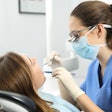The National Association of Dental Plans (NADP) is asking the U.S. Department of Health and Human Services (HHS) to ensure equitable treatment of Americans with dental policies both inside and outside the health exchanges that will be required starting in 2014 as part of the healthcare reform act.
In a statement issued February 2 in response to a December 16 HHS bulletin on essential benefits, the NADP urged HHS to allow consumers to keep the dental policies and dentists they have now and encouraged flexibility for the states to choose from various dental policies currently in the marketplace.
"The practical and political stakes could not be higher; 43.7 million employees and dependents have dental policies today through 1.65 million small businesses that are now vulnerable to disruption when the exchanges become effective in 2014," commented Evelyn Ireland, NADP's executive director. "And for consumers that are getting dental coverage for the first time, the dental-specific benchmark options provided in the bulletin may not be affordable."
The HHS bulletin allows the states to adopt their own essential health benefits by using benchmarks identified by HHS. Under this approach, a state can choose a medical benchmark that includes the state's mandated benefits and have those mandates included as part of federally subsidized coverage. While the bulletin includes specific dental benchmarks for states to use when "pediatric oral services" are missing from the selected medical benchmark, the proposed dental-specific benchmarks are not typical for the dental market.
If "pediatric oral services" are to include services that are typically covered under a dental policy, NADP suggested that HHS both clarify the trigger for adding benefits from a dental-specific benchmark and allow states to use the dental policies parallel to the four main health benchmarks as a way of keeping coverage affordable.
The NADP made the following recommendations to HHS:
- Align inside and outside exchange rules to provide for equitable treatment for consumers in all markets.
- Consumers with dental coverage should not be required to purchase duplicative coverage.
- Set the age range for "pediatric" at the federal level.
- Clarify when a state must supplement its medical benchmark with a dental-specific benchmark to meet the "pediatric oral services" of the essential health benefits (EHB).
- Provide flexibility to the states to fill in "missing pediatric oral services" by using the dental plan offered in any of the categories of medical plan benchmarks.
- Allow states to utilize plan benefits and cost sharing typical in dental plans.
- HHS should affirmatively state if "medically necessary" orthodontia is part of the EHB and covered under a medical benchmark.



















